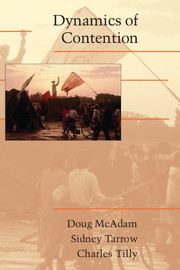Book contents
- Frontmatter
- Contents
- List of Figures and Tables
- Preface and Acknowledgments
- Abbreviations
- Part I What's the Problem?
- Part II Tentative Solutions
- Part III Applications and Conclusions
- 7 REVOLUTIONARY TRAJECTORIES
- 8 NATIONALISM, NATIONAL DISINTEGRATION, AND CONTENTION
- 9 CONTENTIOUS DEMOCRATIZATION
- 10 CONCLUSIONS
- References
- Index
7 - REVOLUTIONARY TRAJECTORIES
Published online by Cambridge University Press: 05 June 2012
- Frontmatter
- Contents
- List of Figures and Tables
- Preface and Acknowledgments
- Abbreviations
- Part I What's the Problem?
- Part II Tentative Solutions
- Part III Applications and Conclusions
- 7 REVOLUTIONARY TRAJECTORIES
- 8 NATIONALISM, NATIONAL DISINTEGRATION, AND CONTENTION
- 9 CONTENTIOUS DEMOCRATIZATION
- 10 CONCLUSIONS
- References
- Index
Summary
Let us begin to put the approach developed in Part II to a greater test. There we settled for showing that similar mechanisms can be identified in dissimilar episodes and used to clarify causal connections within those episodes. Now we ask if the sorts of mechanisms we uncovered within those episodes can illuminate the complex processes that others have lumped together as “revolutions,” “nationalism,” and “democratization.” We will see that they do. To make our case, we extend the comparison of episodes to very large transformations that are usually compared only to each other. Chapter 7 compares revolutionary processes and their successes and failures in late twentieth century Nicaragua and China. Chapter 8 compares state integration and disintegration in nineteenth century Italy with their counterparts in the twentieth century Soviet Union. Chapter 9 closes the trilogy by comparing processes of democratization (and sometimes of de-democratization) in nineteenth century Switzerland and twentieth century Mexico. In Chapter 10 we turn to some unanswered questions and further test the robustness of our approach by applying some combinations of mechanisms that we identified from one set of cases to others in our repertoire as well as to three entirely new episodes.
Between Origins and Outcomes in the Comparative Study of Revolution
In an influential review essay, Jack Goldstone described two early generations in studies of revolution, the first focussing on “natural histories” of revolution and the second on “structural strain” (Goldstone 1980).
Information
- Type
- Chapter
- Information
- Dynamics of Contention , pp. 193 - 226Publisher: Cambridge University PressPrint publication year: 2001
Accessibility standard: Unknown
Why this information is here
This section outlines the accessibility features of this content - including support for screen readers, full keyboard navigation and high-contrast display options. This may not be relevant for you.Accessibility Information
- 14
- Cited by
